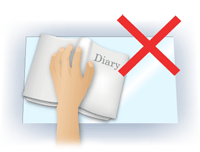Adjusting Image Settings (LiDE 700F)
| Article ID: ART152423 | | | Date published: 05/22/2015 | | | Date last updated: 10/02/2015 |
Description
Solution
Adjusting Image Settings (LiDE 700F)
Image Settings allows you to set the following items:
Reference:
- The setting items vary depending on whether Select Source is Platen (paper/photo) or film.
Auto Tone
Unsharp Mask
Descreen
Reduce Dust and Scratches
Fading Correction
Grain Correction
Backlight Correction
Gutter Shadow Correction
Exposure/Tone Settings (Film only)
When this is set to ON, the brightness of the specified portion of the image is automatically optimized. The result of the color adjustment will be reflected in the entire image. This setting is ON by default.
Important:- You can set Auto Tone after preview.
- You can set this setting when Recommended is selected on the Color Settings tab of the Preferences dialog box.
- When you click Multi-Crop, this setting turns to ON and you cannot change it.
The color tone may change from the source image due to the Auto Tone function. In that case, set Auto Tone to OFF.
Unsharp MaskWhen this is set to ON, the outline of the subjects is emphasized to sharpen the image. This setting is ON by default.
DescreenPrinted photos and pictures are displayed as a collection of fine dots. "Moire" is a phenomenon where uneven gradation or a stripe pattern appears when such photos or pictures printed with fine dots are scanned. Descreen is the function for reducing this moire effect. This setting is OFF by default.
Reference:- Even if Descreen is set to ON, some moire effects may remain if Unsharp Mask is set to ON. In that case, set Unsharp Mask to OFF.
- Selecting Magazine(Color) in Select Source in Basic Mode tab has the same effect as setting Descreen to ON in Advanced Mode tab.
Reduce Dust and Scratches
Scanned photos and film may contain white dots caused by dust or scratches. Use this function to reduce such noise. This setting is None by default.
- None - Dust and scratches will not be reduced.
- Low - select this to reduce small dust particles and scratches. Large ones may remain.
- Medium - It is recommended that you normally select this setting.
- High - select this to reduce small/large dust particles and scratches. Evidence of the reduction process may remain and may also remove delicate parts of the image.
Reference:
- It is recommended that you select None when scanning printed materials.
- When the resolution is set to 4801 dpi or higher and Reduce Dust and Scratches checkbox is selected, images are scanned at an optical resolution of 4800 dpi then interpolated by the software to yield the specified resolution.
Fading Correction
Use this function to correct photos and film that have faded with time or have a colorcast. Colorcast is a phenomenon where a specific color affects the entire picture due to the weather or ambient strong colors. This setting is None by default.
- None - Fading correction will not be applied.
- Low - Select this to correct a small amount of fading and colorcast.
- Medium - It is recommended that you normally select this setting.
- High - Select this to correct a large amount of fading and colorcast. This can affect the tone of the image.
- You can set Fading Correction after preview.
- Fading Correction may not be effective if the scan area is too small.
- You can set this setting when Recommended is selected on the Color Settings tab of the Preferences dialog box.
- When you click Multi-Crop, this setting turns to None and you cannot change it.
Use this function to reduce graininess (roughness) in photos taken with high-speed or sensitized film. This setting is None by default.
- None - Graininess will not be reduced.
- Low - Select this when the photo is slightly grainy.
- Medium - It is recommended that you normally select this setting.
- High - Select this when the photo is very grainy. This can affect the gradation and sharpness of the image.
Use this function to correct photos and film that have been shot against light.
When you change the Backlight Correction setting, the result will be reflected in the preview image.
- None - Backlight correction will not be applied.
- Low - Select this to correct slightly backlit photos. This will not affect the image contrast.
- Medium - It is recommended that you normally select this setting.
- High - Select this to correct strongly backlit photos. This can affect the image contrast.
- You can set Backlight Correction after preview.
- You can set this setting when Recommended is selected on the Color Settings tab of the Preferences dialog box.
- Backlight Correction may not be effective if the scan area is too small.
- When you click Multi-Crop, you cannot change this setting.
Noise patterns may appear when Backlight Correction is applied. Applying Grain Correction and setting Unsharp Mask to OFF may reduce the noise patterns.
Gutter Shadow Correction
Use this function to correct shadows that appear between pages when scanning open booklets.
When you set the Gutter Shadow Correction setting in the preview image, the result will be reflected. Preview the effects before scanning, as results vary depending on the type of document and how it is pressed.
Unclear or blurred text/lines caused by curved pages are not corrected.
- None - Gutter shadow will not be corrected.
- Low - Select this when the effect level is too strong with the medium setting.
- Medium - It is recommended that you normally select this setting.
- High - Select this when the effect level is too weak with the medium setting.
- Do not place items that weigh 4.4 lbs (2.0 kg) or more on the Platen. Also, do not press on the document with a force exceeding 4.4 lbs (2.0 kg). If you press heavily, the scanner may not work correctly or you might break the glass.
- When you click Multi-Crop, this setting is not available. Click Reset then change the setting.
- Align the document with the edge of the Platen. If not, the shadow will not be corrected properly.

- Shadows may not be corrected properly depending on the document. If the page background is not white, shadows may not be detected correctly or may not be detected at all.
- While scanning, press down on the spine with the same amount of pressure you used to preview the scan. If the binding part is not even, the shadow will not be corrected properly.

- How to place the document depends on your model and the document to be scanned.
Reference:
- Cover the document with black cloth if white spots, streaks, or colored patterns appear in scan results due to ambient light entering between the document and the Platen.
- If the shadow is not corrected properly, adjust the cropping frame on the preview image.
Exposure/Tone Settings (Film only)
- Manual Exposure - This function enables you to adjust the exposure data according to the film. This checkbox is not selected by default.
When this checkbox is not selected, the optimal exposure data (the exposure level for each RGB channel and compensation levels) is automatically set according to the color density of the portion within the cropping area of the film.
Select this checkbox if you intend to adjust the image using an application after it is scanned or to scan with an under-exposed or over-exposed effect.
After you select this checkbox, you can adjust the exposure in 1% increments within the range of 50% to 200%. Selecting this checkbox sets Auto Tone to OFF.
Reference:
- Manual Exposure is not available in Basic Mode. To change exposure, select the Manual Exposure checkbox in Advanced Mode tab, then adjust the value and scan.
- When this checkbox is not selected, the time required for scanning varies by film since the exposure is automatically optimized according to the film.
- Apply the tone value to all frames (crops) - "all frames" is displayed in thumbnail view, and "all crops" is displayed in whole film image view.
Click OK to reflect the color adjustment data of the selected film frame or the portion within the selected cropping frame into other frames. This color adjustment data will be used in subsequent scans. It will remain in effect until you click Reset.
This is useful when you want to scan film of photos taken on the same day in the same place, in a consistent color tone.
